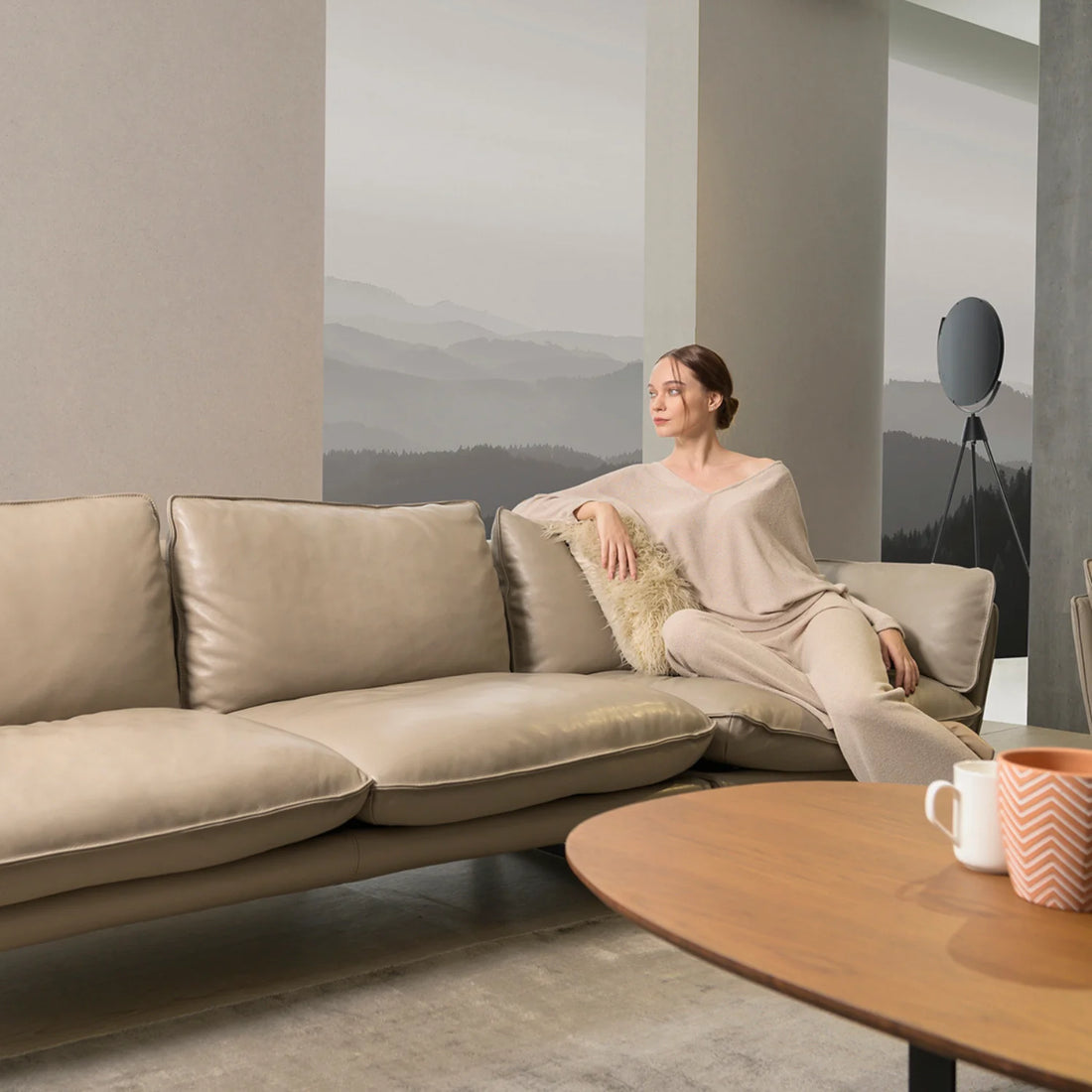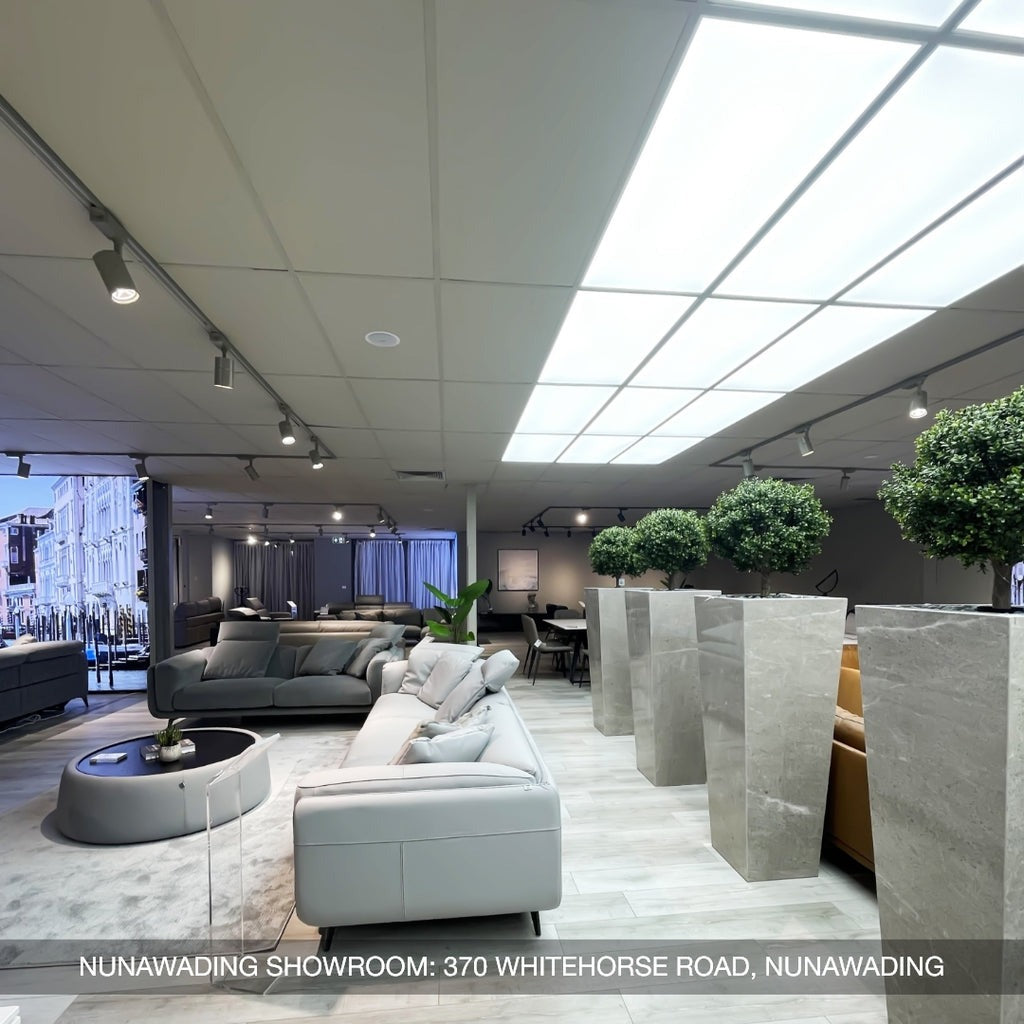Leather sofas have long been cherished for their timeless elegance and exceptional durability. From classic to contemporary styles, they effortlessly enhance the ambiance of any living space. This article delves into the fascinating world of leather sofas, exploring the vast array of options available.
Within the realm of interior design, there exists a rich tapestry of ten distinct types of leather sofas. Each variety possesses unique characteristics, ranging from the luxurious and supple feel of full-grain leather to the rugged charm of distressed leather. Whether you prefer the sleek lines of a modern design or the cozy embrace of a traditional piece, this classification of leather sofas promises to captivate and inspire.
Real Leather Types (Pros and Cons)
Full Grain Leather
Full Grain Leather
Full grain leather is the highest quality leather and comes from the top layer of the hide, where the natural grain and imperfections are preserved. It retains the original texture, scars, and marks of the animal's skin.

Trento 2 seater sofa offers a deep seat, a comfortable stretch foam cushion, and a high and slim armrest with full grain leather.
This type of leather is highly durable, as it hasn't been sanded or buffed to remove imperfections. With time, full grain leather develops a patina, showcasing its unique character and enhancing its aesthetic appeal. It's favored for its authenticity, strength, and the way it ages beautifully over the years.
Pros:
- Exceptionally durable, making it long-lasting and resistant to wear and tear.
- Natural appearance and texture, showcasing the unique markings and characteristics of the animal hide.
- Develops a rich patina over time, enhancing its beauty and adding to its aesthetic appeal.
- Breathable and comfortable, allowing for better air circulation and temperature regulation.
Cons:
- Expensive compared to other types of leather for sofa due to its high quality and craftsmanship.
- Prone to scratches and stains, requiring regular care and maintenance to keep it looking pristine.
- Requires regular conditioning and moisturizing to prevent drying out and cracking.
Top Grain Leather
Derived from the uppermost layer of the hide, top grain leather retains its natural grain but might undergo slight sanding or buffing to remove surface imperfections. This process can also make the leather smoother and more consistent in appearance.

Full Leather 100 % Top Grain - The Italian New Club leather brand is tanned using Eco technology at COZY.
While maintaining some durability and the presence of natural grain, top grain leather may lack the unique aging characteristics found in full grain leather.
Pros:
- High-quality and durable, offering excellent longevity and resistance to wear.
- Smooth and uniform appearance, providing a sleek and refined look.
- Resistant to stains and spills, making it easier to clean and maintain.
- Breathable and comfortable, allowing for airflow and preventing overheating.
Cons:
- Can be costly compared to other leather types and quality because of its craftsmanship.
- May lack the natural texture and character of full grain leather.
- Requires regular maintenance and conditioning to preserve its appearance and prevent drying out.
Corrected Grain Leather:
Corrected grain leather is achieved by sanding or buffing the surface to remove imperfections like scars or blemishes. After this, an artificial grain pattern is embossed onto the leather to provide a consistent appearance. While corrected grain leather might lack the natural charm of other types, it often has a more uniform look.
Pros:
- Affordable option, making it more budget-friendly compared to full or top grain leather.
- Uniform appearance without blemishes or imperfections, offering a consistent look.
- Easy to clean and maintain, as it resists stains and spills.
- More resistant to scratches and scrapes compared to other leather types.
Cons:
- Lower quality compared to full or top grain leather in terms of durability and aging.
- Can feel less natural and more synthetic due to the correction process.
- Prone to peeling and cracking over time, especially with extended use and exposure to harsh conditions.
Split Grain Leather:
Split grain leather is obtained by separating the top grain from the lower layers of the hide. The result is a thinner and less durable leather. To compensate for this, split grain leather is often coated with layers of paint or polyurethane to enhance its appearance and durability. It's commonly used for suede and other more delicate leather products.

Split grain leather is obtained by separating the top grain from the lower layers of the hide.
Pros:
- More affordable compared to full or top grain leather, making it a budget-friendly option.
- Can have a unique texture and character, adding a distinct aesthetic appeal.
- Breathable and comfortable, allowing for good air circulation.
- Can develop a desirable aged look over time, gaining a charming patina.
Cons:
- Less durable than full or top grain leather, as it is made from the lower layers of the hide.
- Prone to damage and tearing, requiring careful handling and maintenance.
- Requires regular conditioning and moisturizing to prevent drying and cracking.
- May not have the same premium appearance and longevity as higher-quality leathers.
Bonded leather is created by binding leather fibers together with polyurethane or other substances. It's often composed of leftover scraps of leather that have been combined to form sheets.

Made by binding leather fibers with polyurethane, bonded leather is less durable and contains a smaller percentage of actual leather.
While it may contain a small percentage of real leather, bonded leather is generally considered of lower quality compared to other leather types due to its composition.
Pros:
- More affordable compared to genuine leather, offering a cost-effective option.
- Available in various colors and styles, providing versatility in design choices.
- Easy to clean and maintain, as it resists stains and spills.
- Can resemble genuine leather in appearance, providing a similar aesthetic.
Cons:
- Lower quality and durability compared to genuine leather.
- Prone to peeling and cracking over time, especially with heavy use.
- Lacks the natural feel and breathability of real leather, as it is made from leather scraps bonded with other materials.
- Can deteriorate over time and may not age gracefully like genuine leather.
Nubuck Leather:
Nubuck leather is produced by sanding or buffing the top grain to create a soft, velvety texture. This process makes the leather more porous and delicate, and it's more susceptible to staining and wear. Nubuck has a unique appearance, similar to suede but typically finer, and it requires careful maintenance to retain its look.
Pros:
- Soft and luxurious texture, offering a plush and comfortable feel.
- Breathable and comfortable, allowing for better air circulation.
- Develops a desirable patina over time, adding to its character and charm.
- Resistant to wear and tear, making it durable and long-lasting.
Cons:
- Requires regular maintenance and conditioning to keep its softness and prevent drying.
- Prone to stains and scratches, requiring careful handling and cleaning.
- Can be expensive compared to other leather types due to its unique texture and quality.
Pony Skin Leather
Pony skin leather is made from the hides of small animals like calves or ponies. It features a unique texture and pattern, often resembling animal fur. The leather is treated and processed to create a durable and distinctive material used in fashion and accessories.

Leather made from the hide of small animals, like calves or ponies, known for their unique textures and patterns.
Pros:
- Unique and exotic appearance, adding a statement piece to any space.
- Luxurious and soft texture, providing a plush and tactile experience.
- Can be a sustainable option when sourced ethically.
- Offers a distinctive aesthetic appeal with its animal print patterns.
Cons:
- Not suitable for everyone's taste, as it can be a bold and unconventional choice.
- Can be expensive due to its rarity and uniqueness.
- Requires delicate care and maintenance to preserve its appearance and texture.
- May not be as durable as other leather types.
Patent Leather:
Patent leather is coated with a high-gloss finish, creating a shiny, reflective surface. This coating is often plastic or lacquer-based, giving patent leather its distinctive appearance. It's frequently used in formal footwear and accessories, known for its eye-catching look.
Pros:
- Glossy and reflective appearance, adding a sleek and modern touch to designs.
- Water-resistant and easy to clean, making it convenient for everyday use.
- Offers durability and long-lasting performance.
- Provides a polished and sophisticated look suitable for formal settings.
Cons:
- Prone to scratches and scuffs, requiring careful handling to maintain its shine.
- Can be stiff and less breathable compared to other leather types.
- Requires special care to maintain its glossy finish and prevent cracking.
- May not have the same natural look and texture as other leathers.
Genuine Leather:
"Genuine leather" is a term that can be misleading. While it does indicate real leather, it's often a lower-quality grade. Genuine leather is typically made from layers of scrap leather that are bonded together with adhesives. It lacks the durability, character, and aging potential of higher-quality leather types like full grain or top grain leather.
Pros:
- Affordable compared to higher-end leathers, offering a cost-effective option.
- Natural appearance and texture, showcasing the unique characteristics of the hide.
- Can develop a patina over time, adding to its beauty and individuality.
- Offers a range of options in terms of quality and price, catering to various budgets.
Cons:
- Lower quality and durability compared to full or top grain leather.
- Can vary in quality depending on the source and manufacturing process.
- Requires regular maintenance and conditioning to prevent drying and cracking.
- May not have the same premium look and feel as higher-quality leathers.
Faux Leather Types (Pros and Cons)
Faux leather, a popular choice for sofa upholstery, offers a polished, high-gloss look without the need for genuine leather. Made from a plastic base coated with wax, dye, or polyurethane, it provides an affordable alternative. Its durability makes it ideal for homes with pets and children, requiring minimal maintenance.

Faux leather also boasts stain resistance, offering peace of mind. Unlike real leather, it won't fade from UV rays, making it suitable for sunny areas. As a vegan option, it appeals to many with its wide range of colors and finishes, providing versatility and style for sofa leather material.
Discover the exceptional quality and comfort of our eco leather sofas at COZY. Crafted with meticulous care, our sofas are made from microfiber leather, an eco-friendly alternative to traditional leather. This synthetic material, composed of polyester and polyurethane, provides a soft and supple texture that closely resembles genuine leather, yet offers enhanced resistance to scratches and stains.

Meticulously crafted, our sofas or chairs are made from microfiber leather, an eco-friendly alternative to traditional leather.
Cleaning and maintenance are a breeze, making our microfiber leather sofas perfect for households with a busy lifestyle. Embrace the beauty of our eco leather sofas, knowing that you've made an environmentally conscious choice. Explore our collection at COZY and find the best leather fabric sofa to elevate your living space.
Pros:
- Affordable: Faux leather is generally more budget-friendly compared to genuine leather.
- Wide Variety: It is available in a wide range of colors, textures, and patterns, allowing for versatile design options.
- Animal-Friendly: Faux leather is cruelty-free and doesn't involve the use of animal products, making it suitable for vegans and animal rights advocates.
- Stain Resistance: Faux leather is resistant to stains, spills, and liquid penetration, making it easier to clean and maintain.
- Uniform Appearance: It often has a consistent and uniform look, without the natural variations found in genuine leather.
- Hypoallergenic: Faux leather doesn't typically trigger allergies or sensitivities related to animal products.
Cons:
- Less Breathable: Faux leather is less breathable compared to genuine leather, which can make it feel warmer and less comfortable in hot weather.
- Durability: While faux leather is generally durable, it may not be as long-lasting or resilient as genuine leather.
- Not Biodegradable: Faux leather is typically made from synthetic materials, which can contribute to environmental waste as it is not biodegradable.
- Less Authentic Feel: The texture and feel of faux leather may not match the luxurious and supple qualities of genuine leather.
- Susceptible to Peeling: Over time, faux leather may experience peeling or cracking, especially with heavy use or exposure to harsh conditions.
- Limited Aging: Unlike genuine leather, faux leather does not develop a natural patina or age gracefully with time.
FAQs
How to Identify the Real Leather Sofa?
How to Identify the Real Leather Sofa?
When selecting a leather sofa, it's important to examine the details. For faux leather sofas, check the tag or label for any mention of "100% real leather," "full/top grain leather," or "genuine leather." These indicators confirm the use of real leather.

When you touch the leather, it won't feel completely smooth but rather have a slight flexibility and wrinkling, resembling human skin.
Additionally, inspect the surface closely; real leather will have slight imperfections and variations, reflecting its natural origin. When touched, genuine leather won't feel perfectly smooth and will exhibit some flexibility and wrinkling, akin to human skin. Lastly, give it a whiff - authentic leather carries a distinct organic scent that cannot be replicated. Remember these cues while exploring the world of leather sofas.
How Long Should a Good Leather Sofa Last?
Experts in furniture agree that the lifespan of a quality leather sofa can range from 20 to 25 years, and with diligent care, it may endure for up to 40 years. This longevity is a testament to the durability and resilience of luxurious Italian sofas and stylish leather sofas.
By investing in a well-crafted piece and following recommended maintenance practices, you can enjoy the comfort and sophistication of these types of leather sofas for decades to come. Whether you're seeking timeless elegance or contemporary allure, a carefully chosen leather sofa is a reliable investment that will elevate your living space for years on end.
What is The Best Leather Sofa For Your Family?
When it comes to finding the best leather sofa for your family, full grain leather stands out as a top choice. Regarded as the longest-lasting and highest-quality grade of leather, it offers exceptional durability and resilience. Full grain leather retains the natural pattern and texture of the animal's skin, giving it a soft and authentic appearance.

Its warm feel adds to the overall comfort of the sofa for your living room.
Its warm feel adds to the overall comfort of the sofa. Being sourced from the top layer of the cow's hide, full grain leather possesses superior strength and breathability compared to other types of leather. If you prioritize longevity, quality, and a luxurious feel, full grain leather sofas are an excellent option for your family.
Conclusion
In this exploration of 10 different types of leather sofas, we have discovered a diverse range of options to suit various preferences and styles. From the timeless elegance of full grain leather to the affordable versatility of bonded leather, each type offers unique characteristics and benefits.
Whether you prioritize durability, comfort, or a vegan-friendly choice, there is a type of leather sofa that fits your needs. From the sleek and modern appeal of patent leather to the soft and luxurious texture of nubuck leather, these variations provide ample opportunities to elevate your living space. With this classification of types of leather sofas, you can confidently choose the perfect option for your home.




